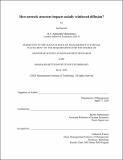How network structure impacts socially reinforced diffusion?
Author(s)
Sassine, Jad(Jad Georges)
Download1191221577-MIT.pdf (1.204Mb)
Other Contributors
Sloan School of Management.
Advisor
Hazhir Rahmandad.
Terms of use
Metadata
Show full item recordAbstract
Social scientists have long studied adoption choices that depend on the number of prior adopters. What is the effect of network structure on such adoption dynamics? The emerging consensus holds that when agents require a high reinforcement threshold for adoption, clustered networks are better conduits of social contagion than random ones. Using models with deterministic thresholds this argument formalizes the idea that transmission will get 'stuck' should the number of neighboring adopters fall below a threshold. In this paper, we explore the effect of stochastic thresholds on the diffusion races between random and clustered networks. We show that even low probabilities of adoption upon a single contact would tilt the balance in favor of random networks, a tendency that is reinforced with the size of the network. Moreover, if repeated signals from the same adopter can reinforce a message, random networks are further promoted. However, we also show that clustered networks can still be preferred over random networks if adopters become 'inactive' - i.e. they stop sending messages - with high probability. These findings refocus our theoretical understanding of how network structure moderates social influence, and raises new questions on contagion phenomena that benefit from clustered networks.
Description
Thesis: S.M. in Management Research, Massachusetts Institute of Technology, Sloan School of Management, May, 2020 Cataloged from the official PDF of thesis. Includes bibliographical references (pages 27-28).
Date issued
2020Department
Sloan School of ManagementPublisher
Massachusetts Institute of Technology
Keywords
Sloan School of Management.